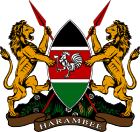
Back Subcontee del Kenya Italian Lista de subcondados do Quénia Portuguese Wilaya, tarafa na kata za Kenya Swahili
 |
|---|
|
|
Sub-counties, also known as Districts, are the decentralised units through which government of Kenya provides functions and services.[1] At national level, sub-counties take a more administrative function like security, statistical purposes, provision of government services, etc. Even though the sub-counties are divisions of counties, powers to create new national sub-counties lies with the national government. As of 2023, there are 314 sub-counties, compared to 290 constituencies. A deputy county commissioner is appointed by the state to lead each sub-county. The sub-counties are further divided into divisions, locations and sub-locations.
Districts were introduced in Kenya by the colonial government for ease control and management of the colony. The number of districts in Kenya through the colonial period varied. Headed by District Commissioners (DC), districts were the second level of administration after the provinces. In 1962, as the colony was transitioning to self-rule, the colonial government redrew the districts and capped them at forty, in addition to the Nairobi Area.[2] A bicameral parliament meant that the districts were to send one senator to the Senate. In 1966, the Senate was abolished by an amendment to the constitution, making the districts purely administrative. By 1992, one district had been eliminated, five more had been created by splitting some of the existing districts. By the start of the 21st century more districts had been created, and by 2005, seventy two districts were in existence, and by 2010, Kenya had 265 districts. In 2009, the High Court declared all districts created after 1992 unlawful, though they remained functional.
Under the former Constitution of Kenya, the Provinces of Kenya were subdivided into a number of districts (wilaya). In line with restructuring the national administration to fit with the devolved government system brought in by the 2010 Constitution, that came into full effect following elections in March 2013, the 8 provinces and their administrators and districts were replaced by County Commissioners at the county level, while former districts existing as of 2013 were re-organised as sub-counties, and had Deputy Commissioners appointed over them.[3]
At county government level, except for the parts which fall under urban areas, sub-counties coincide with the constituencies created under article 89 of the Constitution of Kenya.[4] In that case, constituencies are sometimes referred to as 'sub-counties' at county management level, but defer significantly from the sub-counties at national level. The sub-counties have a sub-county administrator, appointed by a County Public Service Board.[5] The sub-counties or constituencies in this case are further divided into wards and villages. The county governments are mandated to appoint administrators in both decentralised levels.
- ^ Decentralized Units, Section 48 (1) (b) County Governments Act 2012
- ^ "Kenya Gazette dated 2nd April, 1963" (PDF). Gazettes.Africa. Retrieved 2 October 2023.
- ^ Momanyi, Bernard (11 May 2012). "Kibaki names 47 County Commissioners". Capital News. Archived from the original on 14 March 2021. Retrieved 21 July 2023.
- ^ Decentralized Units, Section 48 (2) County Government Act, 2012
- ^ Office of the sub-county administrator, section 50, County Government Act 2012
© MMXXIII Rich X Search. We shall prevail. All rights reserved. Rich X Search